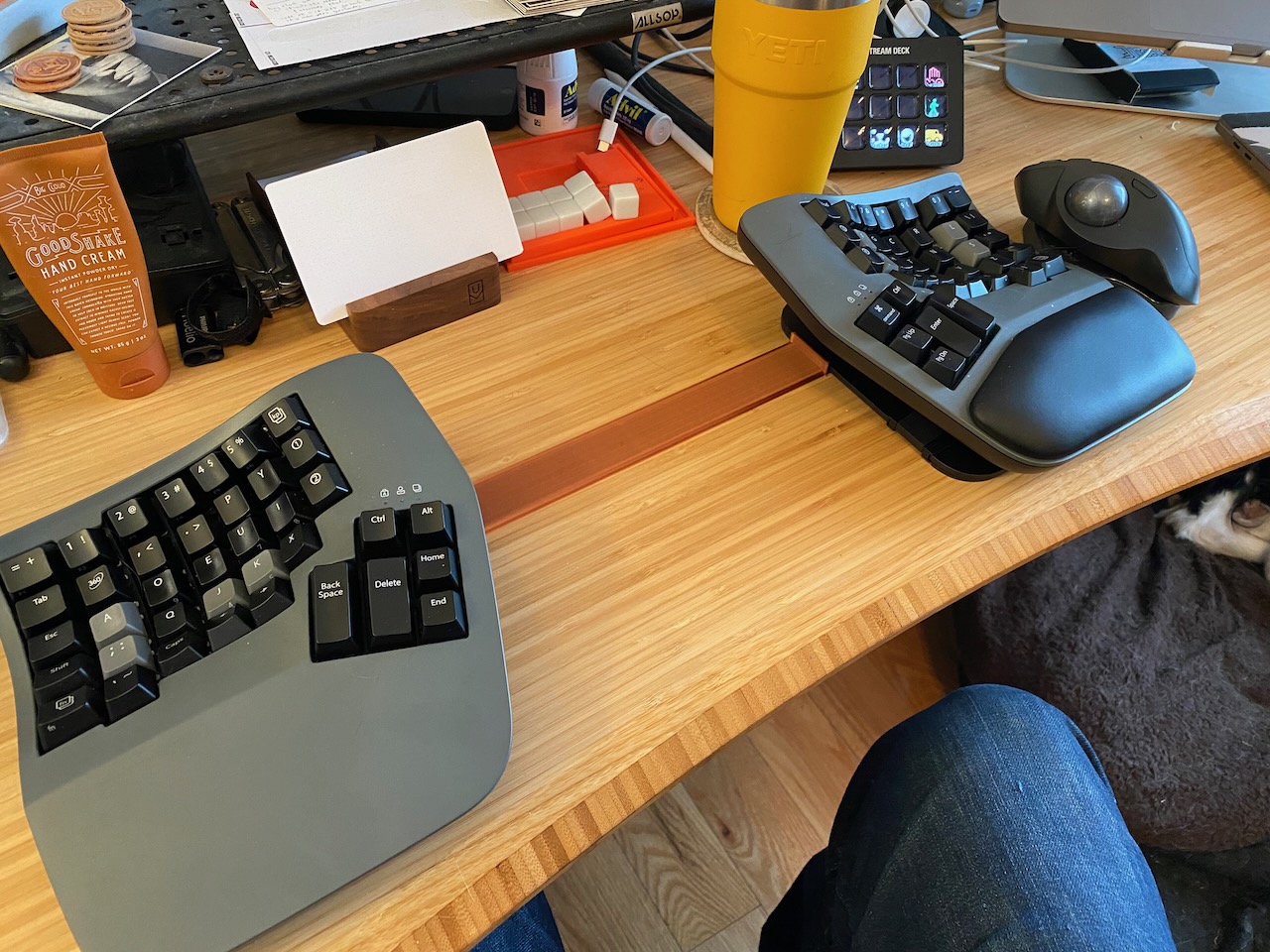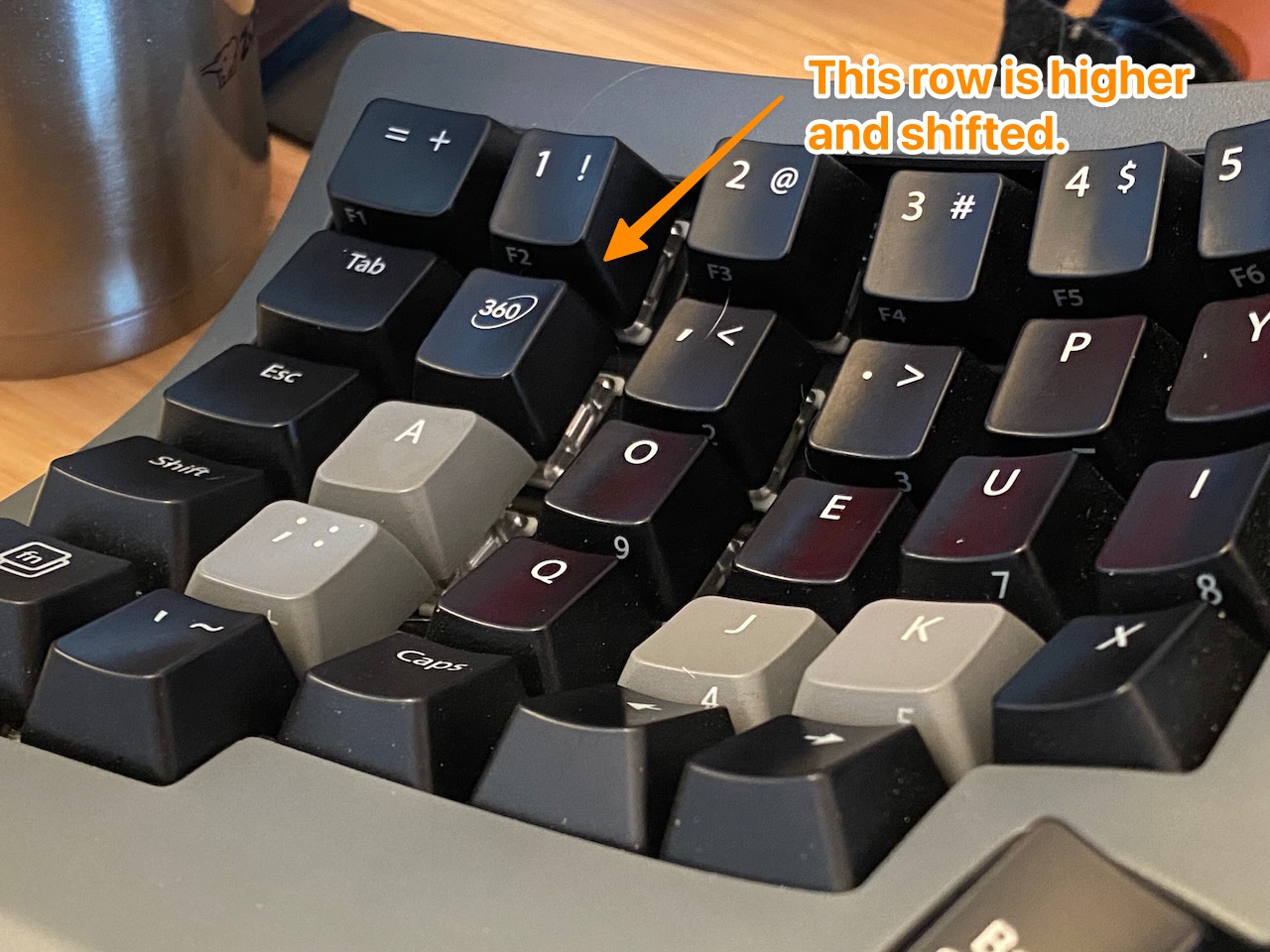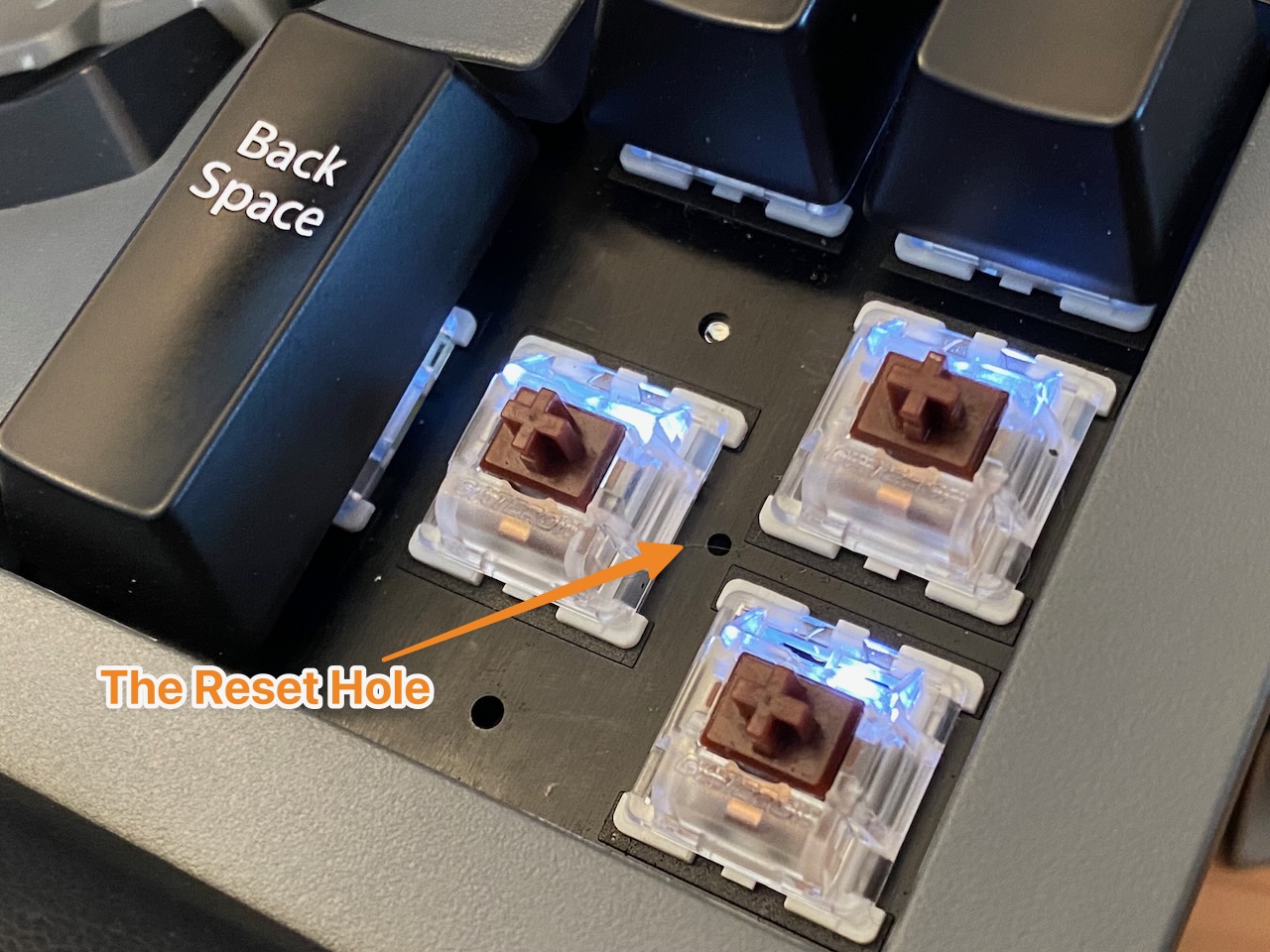Kinesis Advantage 360 Pro Review

High Level Summary
The Kinesis Advantage 360 Pro feels great. The ergonomics are better than the Advantage 2. The Bluetooth is buggy. The on/off switches are terrible. The mechanism for resetting it is worse than terrible. I’m still irked that the wrist wrests weren’t included at that price, and I suspect the Mo Ergo Glove80 is going to be an equal, or even better choice.
The Hope
I have been a fan of the Kinesis Advantage keyboards for a while. There were 3 things that I wished that they’d change.
-
The escape key and F-keys were not made to the same standards as the other keys.
This is probably fine for the F-keys which are essentially never used, but not for the escape key which is used relentlessly by Vim and Emacs users, and by anyone who knows that you can get out of most any dialog by hitting it instead of reaching for your mouse. I’ve had to buy 2 replacement Advantage 2s because of this failing key.
-
No Bluetooth.
This sucks if you’re a remote worker, and have a work computer and a home computer. Constantly plugging and unplugging. Yes, I hear you saying there are USB-A Switches, and this is true, but I have gone through multiple of those that just die. They’re almost all cheap Chinese crap, made barely well enough to survive the return window and nothing more, and be so cheap to begin with that it’s not worth the effort of returning anyway.
-
It’s not a split keyboard.
You spend all the $$$ on a Kinesis Advantage keyboard because you’re someone who cares about ergonomics. At the same time, the keywells being so close together forces you to angle your arms inward to get to them, and then compensate for that by bending your wrists outwards to be inline with the keys.
The Good
- It’s got multi-device bluetooth.
- They got rid of the terrible F-keys, but left space for an escape key.
- There’s a GUI keyboard layout editor (kind-of).
- It’s a split keyboard so you can spread the keywells as far apart as you need.
- It’s even more comfortable to type on than the Advantage 2
- The wrist wrests are magnetically attached and washable.
- The Advantage 2 was so light as to feel cheap. The 360 has enough heft to it that you feel that you’re getting your money’s worth. This is of course ridiculous psychological BS that has no bearing on the real usability or quality of the keyboard, but what can I say? My monkey-brain thinks “heavy keyboard == better quality”.
- It includes a keycap puller and a handful of spare keycaps.
- It’s easy to angle the halves outward, and the metal mechanism feels sturdy.
The Meh
-
The wrist wrests are magnetically attached, which means that they frequently get shoved off, or shift around slightly as you move.
-
You can’t buy it in Dvorak.
-
The documentation is “meh”. It isn’t specific enough in places where I want it to be, and the table of contents in the PDF isn’t clickable to get to the relevant section of the document.
-
The two outermost columns of keys are oddly unaligned.
The columns thing is weird, and hard to capture in photos. It’s only a “meh” because my fingers can’t tell, but it looks like there’s something wrong with the keyboard, like maybe I didn’t push down those keycaps far enough. Those two columns are shifted down and also physically higher. I’m confident this is mostly to address ergonomic concerns around finger length, but the fact that it’s lifted up too, and exposing the keyswitches to your eye-line makes it “look” like a fuck-up.

The Not Good
- The rubber feet aren’t fricative enough. Without a plastic bridge to connect the two halves my left one just kept migrating away from me as the day progressed.
- The keycaps don’t have little nubbins to tell your index fingers when your hands are in the correct location.
- The wrist wrests not only aren’t included, but are $30 + shipping. I wouldn’t mind $30 for a replacement pair, but when the keyboard itself is $460 this feels cheap.
- The Dvorak keycaps are $80 + shipping.
- There are spare keys that come with it, but there are no spare unlabeled keys, and there are no spare short rectangle keys.
- The plugs for reflashing the firmware (updating the keyboard layout) are USB-C, but the cables that ship with it are USB-C on one end and USB-A on the other.
- You can’t daisy chain the halves for charging. You have to use 2 separate cables to charge them at the same time.
- You can’t update both halves of the keyboard at once. For all intents and purposes these are two separate keyboards.
- The lights under the keys are all white.
- They don’t offer a choice of keyswitches except via a 3rd party.
I’m a touch typist, who uses Dvorak. Essentially every keyboard I’ve typed on for decades has had the “wrong” letters on the keys. I figured I could spend $80 for a set of Dvorak keycaps, or I could just rearrange most of the keys on my keyboard and be left with a few keys that were “wrong” (because of no blank spares). I went with that. I’m still finding myself confused by keys that have the “right” letter on them, and don’t believe what I’m seeing. $80 just seemed wasteful.
The cords that come with it are useless to me except for charging because I have some USB-A charging bricks laying around. I can’t update the firmware / keyboard layout with them, because my computer only has USB-C. I think it’s reasonable to say that anyone who’s willing to plunk down nearly $500 to https://www.moergo.com/ be an early adopter of a fancy new keyboard probably has a modern computer. That means one with USB-C holes not USB-A holes.
Regarding the white lights under the keys: before getting the Keyboardio Model 01 I thought that RGB lights under keys were just some flashy gimmick that didn’t really matter. I was wrong. They are amazing. I loved looking down at that keyboard and seeing a gently shifting rainbow. It brought a tiny bit of happiness to me throughout the day. I asked Kinesis about this at some point, and if memory serves, their response was something to the effect of “it was too complicated” which I interpreted to mean “it added complications we didn’t feel were worth dealing with”. Meanwhile, the folks at Keyboardio managed to get that working even though it was a 2 person shop. I know two people who backed the Kickstarter for the Glove80, which managed it, plus the bluetooth.
Choice of keyswitches isn’t a big deal for average consumer keyboards. These are not average consumer keyboards. They cost so much more, and they are bought by people who are picky about the way their keys feel.
The Bad
Bluetooth
The bluetooth is… annoying. Every time close my laptop lid, and then re-open it I have to turn off bluetooth and turn it back on to get the Advantage 360 to reconnect. I filed a support ticket and they said it’s a known issue, and that they can’t do anything about it, because it’s something on Apple’s end. Now, maybe that’s true. Maybe it’s some weird side-effect of the 2 devices pretending to be one. All I know as a consumer is that every other bluetooth device I own reconnects just fine without me doing that.
Power Switches
The power switches are terrible. Not only are they hard to slide, they don’t slide well and have a position where they’ve been moved but aren’t actually moved far enough, and you can’t really tell if it counted or not.
Charge Indicator
There doesn’t appear to be a way to know how much charge each half has. On the Mac there’s a percentage of charge shown in the bluetooth menu, but it’s a lie. I don’t know what it means. Maybe it’s an average of the charge of both? Maybe it’s just the left one? I dunno. All I do know is that I have to just randomly plug in each half to keep it charged because I have no idea what the actual charge is.
When Things Go Wrong
The right and left halves can “loose ‘sync’ with each other”. It can go for weeks without this happening and then have happened overnight every night. It can happen while you’re typing.
The initial fix is to toggle the power switches “in rapid succession” which is easier said than done because it’s hard to tell if I’ve successfully switched my left switch half the time, and you can’t tell if it didn’t work because you failed to switch the switches or because it’s just not working. Once you’re confident you have successfully turned the halves on in rapid succession and it’s still flashing 3 red lights at you:
- plug the current half into your keyboard
- find a paperclip
- find a hole that is literally impossible to see without removing keycaps
- double click a button in the hole
- drag a new firmware file onto the keyboard half to reset it.
I dunno about you, but in my experience not many people seem to actually have paperclips in their house these days. Worse, there are very few alternate objects that are both that thin, and that rigid. When my keyboard decided to randomly die and need to be reset I honestly thought I was going to be unable to use it for a week until amazon shipped me a box of paperclips. 🤦♀️ Fortunately I found one wedged between the bottom and side of a drawer of pens. Also, why double-click? It’s effectively impossible to accidentally stick something in this hole and click it once.

O.M.G. I hate that hole. It is literally the worst implementation of “stick a paperclip in to reset things” that I have ever seen. It shouldn’t require a paperclip in the first place. That would be mean even if paperclips were a thing people still had laying around.
I’ve had to do this 5 times in the past 2 days. I now have a folder on my desktop with the firmware files for each half so that I can easily drag them on to the drive the next time I need to do this.
The Bridge
Inside the box is a long thing box with keycaps, a keycap puller, the aforementioned useless cables, and a “bridge”. The bridge is a cheap, but well designed piece of plastic that snaps onto the support bars of each half and enable you to keep them rigidly attached to each other. It works well. It doesn’t need to be fancier than it is.
However, it’s only ~6" (15cm) long. This means that if you attach it you’re forcing your arms to angle inwards again because your keyboard isn’t wide enough. The entire point of buying this keyboard is to have a more ergonomic typing experience and prevent wrist strain. It’s baffling that they’d put such a short bridge in it, or that they’d only put a short one in. There’s plenty of space in the box for a longer one, and I’d be very surprised if this part cost them more than 25 cents to make. I designed a wider version for those of you with large-bed 3D printers, or who feel like paying too much to have a 3rd party print it for you. It’s the copper colored strip of plastic between the halves in the image at the top of this post.
Modifying The Keyboard Layout
Tweaking the keyboard layout on this thing is geeky as 💩. I’m a geek so I can handle it, but holy crap.
- You have to clone a Github repo
- Enable Github actions
- Give a 3rd party app permission to write to your your repo.
- Use a janky UI with poor accessibility
- Wait an unknown amount of time for the files to build.
- Know that you should look under actions, for a build artifact. Download a “firmware.zip” file.
- Unzip it
- Find a paperclip to shove in the invisible hole to mount the left keyboard. Oh, but only if it’s flashing, otherwise you can do a key combo. The docs specify paperclip in invisible hole first.
- Drag the left file onto it. If you do the right file onto the left you’ll break things. Be surprised that it auto-unmounts itself and causes you to get yelled at by macOS for improperly unmounting a drive.
- Repeat 8 & 9 for the right half.
For comparison, when the Keyboardio Model 01 had just been released, I had to edit a geeky file, that was very well commented, and relatively easy for a non-geek to work with. Then run an app to load the file onto the keyboard. That was it. No Github. No secondary build process. No “this half, then that half”. It just worked and worked easily. Having a GUI is nice, but they had the keys laid out in the file to match the keyboard. Later on they built the open source Chrysalis layout editor which is really nice. This was years ago. Ergodox also has a graphical configurator that generates the files you need without you to set up a GitHub repo and GitHub actions.
I was hoping that Kinesis would use Crysalis, or something of equal quality considering they’re not just a team of 2 people, but no. It’s nice that their editor is open source but it’s honestly not very good.
The Conclusion
Overall it’s a good keyboard with minor annoyances. Would I buy it again? Given the market today yes. Once the Glove80 starts shipping…. probably not.
I’m reasonably confident from the photos that the ergonomics will be comparable. It has RGB LEDs under each key. It’s got low profile keys which most folks seem to like better. I’ve played with a keyswitch tester for the keys they’re using, and they feel nice. They offer multiple keyswitch options.
I think the Kinesis may have better build quality, and it looks like the Glove 80 can’t angle outwards like the Advantage 360 does.
It’s honestly not a huge difference, but I really want bluetooth I don’t have to reset every day. I lust after those RGB lights. I really dislike the power switches on the Kinesis, and I outright hate the stupid paperclip reset thing.
Update
3 months later.
I start every day with upset grumbling, as I’m forced to remember that my keyboard doesn’t work when I first sit down in the morning. I then turn off Bluetooth on my laptop, and turn it back on. Kinesis claimed this was an Apple problem they couldn’t do anything about. This is provably false, because shortly after writing this my wife received her Glove 80. It does not have this problem.
If she dares to close her laptop lid and reopen it later, her keyboard continues to work. Additionally, the Glove80 can also tell her how much battery each half has, and which device number it’s connected to at the moment. The reset hole isn’t hidden under keys. The power switches aren’t so tiny and fine as to be more easily manipulated with tools. Updating the keyboard layout doesn’t require you to be so geeky as to configure a GitHub repo and understand GitHub workflows.
To top it off, the extra row of keys means that unlike the Kinesis, the capslock key isn’t in a hard to reach location, and the escape key can live where it’s lived for 40+ years instead of having to steal the location of another key. Currently mine lives where capslock key is supposed to be, which means every time I use my laptop’s keyboard I’m constantly switching into upper case letters and invoking the wrong commands in vim / emacs.
I think the Kinesis is better made. I think the Kinesis is prettier. When it comes to actual functionality and everyday use the Glove80 kicks its ass. I was concerned about the low-profile keys on it, but they’re really nice. I can not, in good conscience recommend that anyone buy the Kinesis Advantage 360 Pro when you could instead buy the Glove80.